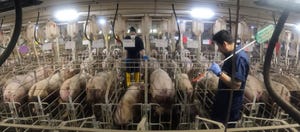China reopens to U.S. poultry
Legislative Watch: China welcomes U.S. poultry; Chinese cooked poultry eligible to come to U.S.; meat industry sets safety record; Japan to vote on trade pact; government to stay open.

China announced it is lifting its ban on the importation of poultry from the United States. The ban took effect in January 2015 because of the avian influenza outbreak in December 2014. The United States has been free of the disease since August 2017.
U.S. Trade Representative Robert Lighthizer says, "The United States welcomes China's decision to finally lift its unwarranted ban on U.S. poultry and poultry products. This is great news for both America's farmers and China's consumers. China is an important export market for America's poultry farmers, and we estimate they will now be able to export more than $1 billion worth of poultry and poultry products each year to China. Reopening China to U.S. poultry will create new export opportunities for our poultry farmers and support thousands of workers employed by the U.S. poultry."
According to the USDA, the United States exported over $500 million worth of poultry products to China in 2013.
Chinese cooked poultry eligible to export to U.S.
Beginning on Dec. 9, China will be eligible to export fully cooked not shelf stable poultry products from poultry slaughtered in China. USDA's Food Safety and Inspection System published a final rule last week to allow for the change in policy. All products will be subject to reinspection by the FSIS. Raw poultry products are not eligible to be exported to the United States for animal health reasons.
This issue of China being allowed to export cooked poultry to the United States has been going on for nearly 15 years. It has been a priority of China but was blocked in the past when various appropriations bills prohibited the FSIS from working on the issue.
Meat industry sets record for worker safety
The North American Meat Institute announced the meat and poultry industry set a new record for worker safety in 2018, according to a recently released Bureau of Labor Statistics report concerning worker injuries and illnesses.
The report according to NAMI found the "Meat industry incident rates improved from both 2017 and 2016 levels, reaching a new, all-time industry low of 4.3 cases per 100 full-time workers (per year). The most serious injuries, those included in the 'Days Away, Restricted, or Job Transfer' rate, also dropped from 2017's 4.6 to 2018's 3.6, also the lowest rates ever recorded."
NAMI President and CEO Julie Anna Potts says, "The data continue to prove the meat and poultry industry is committed to the highest standards of well-being of its employees. The success of our industry depends on a safe and healthy work environment for the 800,000 people who produce meat and poultry."
NAMI will recognize the meat and poultry plants that have achieved "high levels of workplace safety performance" at the 2020 Worker Safety Conference for the Meat and Poultry Industry in Atlanta, Ga., Jan. 28-29.
Japan to vote on trade agreement
The Japanese media is reporting that late next week the Japanese Diet will vote on the U.S.-Japan Trade Agreement. Congress will not have to vote on the agreement.
The agreement will gradually reduce or eliminate tariffs and establish new quotas on $7.2 billion of agricultural products. After the agreement goes into effect Jan. 1, nearly 90% of U.S. food and agricultural exports to Japan will either be duty-free or receive preferential tariff access. The agreement restores much of the market access U.S. agriculture would have received under the Trans-Pacific Partnership.
Avoiding government shutdown
The leadership of the House and Senate appropriations committees have agreed to pass another continuing resolution to keep the federal government running until Dec. 20. Both the House and Senate will need to pass the new CR and President Trump will have to sign it before the current CR expires on Nov. 21 to avoid a government shutdown.
Source: P. Scott Shearer, who is solely responsible for the information provided, and wholly owns the information. Informa Business Media and all its subsidiaries are not responsible for any of the content contained in this information asset.
About the Author(s)
You May Also Like



